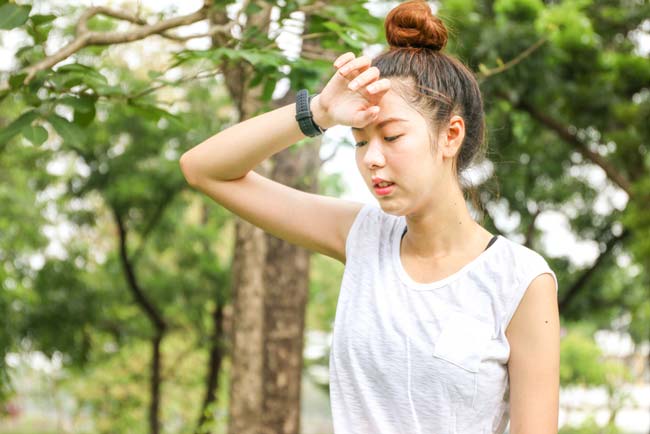You’re trying your best to live a healthy lifestyle — in the gym for a workout session. But it seems like your body is sabotaging your efforts. You have yet another exercise-induced headache.
If you’ve had a few of these nagging headaches, you may feel like they’ll crop up every time you squeeze a workout in. But that doesn’t necessarily have to be the case.
There are steps you can take to make exercise-induced headaches less likely. What you can do to limit headaches depends on the underlying cause of your headache.
There are any number of reasons why a headache occurs, but if yours seem to be tied with physical activity, there are usually a couple common causes. Let’s take a look.
Exercise-induced headaches: Dehydration headaches
Dehydration is a common culprit behind exercise-induced headaches. That’s because dehydration can often crop up during or after a workout, when your body is sweating heavily.
This is especially true during the steaming hot days of summer — or anytime you’re working out or exercising in hot or humid conditions. That isn’t limited to workouts outdoors, either. A warm gym or hot yoga class can cause you to sweat more heavily.
When you sweat, your body is losing fluids and electrolytes. During a normal day, you sweat out a certain amount, but you usually drink enough liquid and eat enough water-laden foods to rehydrate your body.
But during exercise, you sweat out fluids and essential electrolytes much more quickly. If you’re not replenishing your body during your workout, this can lead to what’s known as a “dehydration headache.”
These headaches occur when the body is dehydrated, which causes the brain to temporarily contract, pulling away from the skull and causing pain.
Once you replenish the fluids in your body, the brain will return to normal, which in turn, will help alleviate the headache.
To limit the risk of dehydration headaches, take steps to limit the risk of dehydration! On days you’re exercising, drink plenty of fluids before, during and after exercise.
Don’t wait until you’re thirsty to grab water — by the time you feel thirsty, you’re likely already at least somewhat dehydrated. Instead, sip water continuously throughout the day.
Water is usually sufficient to help replenish the fluids in your body, but if you’re exercising for a long period of time or strenuously, you may benefit from drinking an electrolyte-replenishing beverage. Choose a low-sugar or non-sugar option to replenish those essential nutrients and fluids without filling your body with unnecessary sugar.
Drinking large quantities of liquid during a hard workout can make you feel queasy. So, instead of gulping down your drink, regularly stop and take a sip or two. Ultimately, you want to drink at least 32 ounces of water or an electrolyte beverage for every one hour you exercise.
Exercise-induced headaches: Primary exercise headaches
Dehydration isn’t the only cause behind exercise-induced headaches. There’s another type of headache that experts call “primary exercise headache.”
This type of headache is usually harmless and not connected to an underlying problem, simply occurring during or after a hard or long workout.
If you’re experiencing a primary exercise headache, you’d probably describe your pain as throbbing on both sides of your head. Yes, absolutely unpleasant in the middle of a workout!
Researchers aren’t certain why these exercise-induced headaches occur, but there’s some thought that strenuous physical activity dilates blood vessels in the skull, leading to pain.
What can you do to limit the risk of primary exercise headaches? Well, this is a bit more complicated than a dehydration headache, so you’ll want to talk with your doctor.
Most often, these headaches occur when you’re exercising in heat or humidity, so you can sometimes avoid them by not exercising outdoors or in a hot space. But the heat isn’t always the culprit.
If you find that you’re regularly experiencing exercise-induced headaches in all types of weather and indoors, talk with your doctor about whether taking an anti-inflammatory before your workout might be helpful. Taking a small dose of over-the-counter anti-inflammatory medication a half hour before exercise has been shown as effective in preventing exercise-induced headaches in some cases, but clear it with your doctor before you try it.
If you’re experiencing nagging headaches when you exercise, don’t let that keep you from working out! Talk with your doctor to find a solution. Find a doctor here.







